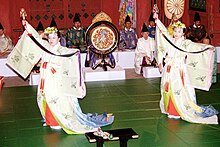Kagura
| Part of a series on |
| Shinto |
|---|
 |
| Beliefs |
| Notable Kami |
| Important literature |
|
| Shinto shrines |
| Practices |
| See also |


Kagura (神楽 (かぐら), "god-entertainment") is a specific type of Shinto ritual ceremonial dance. The phrase is a contraction of "kami no kura (seat of god)", indicating the presence of god in the practice. One major function of Kagura is "Chinkon (purifying and shaking the spirit).", involving a procession-trance process. Usually a female shaman will perform the dance and obtain the oracle from the god----in the setting, the dancer herself turns into god during the performance.[1] Once strictly a ceremonial art derived from kami'gakari (神懸 (かみがかり), "oracular divinification"), kagura has evolved in many directions over the span of more than a millennium. Today, it is very much a living tradition, with rituals tied to the rhythms of the agricultural calendar, thriving primarily in parts of Shimane Prefecture, and urban centers such as Hiroshima.[2]
Mai and Odori[]
There are two major types of kagura----mai and odori. Mai presents the slow circular movement, stressing quiet and elegance; While odori presents quick leaping and jumping, stressing activation and energy. The two types can be understood as two phrases of kagura----the mai is a preparation process for trance and odori is the unconscious trance stage.
During mai dance, the female shaman, surrounded by a group of priests, holds gohei (a ceremonial wand used to cleanse or purify) as well as other sound producing instruments and engages with circling movement to summon deities. Once the female shaman enters a possessed status, she switches into spontaneous leaping movements, which is called odori.[1]
History[]

The epics Kojiki and Nihon Shoki describe a folktale origin for the dances. In these texts, there is a famous legendary tale about the sun goddess Amaterasu, who retreated into a cave, bringing darkness and cold to the world. Ame-no-Uzume, goddess of the dawn and of revelry, led the other gods in a wild dance, and persuaded Amaterasu to emerge to see what the ruckus was all about.[3] Kagura is one of a number of rituals and arts said to derive from this event.
Originally called kamukura or kamikura (神座), kagura began as sacred dances performed at the Imperial court by shrine maidens (miko) who were supposedly descendants of Ame-no-Uzume. During the performance, the shrine maidens usually utilize a channeling device for god such as masks and spears to imitate the trance. With the kagura music that has the power to summon the gods, the miko start to dance to transforming herself into the representation of the gods and receiving messages as well as blessings from the deities.[1] In 1871, Iwami Shinto offices claimed that theatrical kagura performed by priests in the west of Japan demeaned their dignity and therefore banned the performance. Owning to the support of civilian performing groups at that time, the performance pieces were still preserved.[4]
Over time, however, these Mikagura (御神楽) performed within the sacred and private precincts of the Imperial courts, inspired popular ritual dances, called satokagura (里神楽), which, being popular forms, practiced in villages all around the country, were adapted into various other folk traditions and developed into a number of different forms. Among these are miko kagura, shishi kagura, and Ise-style and Izumo-style kagura dances. Many more variations have developed over the centuries, including some which are fairly new, and most of which have become highly secularized folk traditions.
Kagura, in particular those forms that involve storytelling or reenactment of fables, is also one of the primary influences on the Noh theatre.
Imperial Kagura[]
The formal Imperial ritual dances (Mikagura) were performed in a number of sacred places and on a number of special occasions. At the Imperial Sanctuary, where the Sacred Mirror is kept, they are performed as part of gagaku court music. Mikagura are also performed at the Imperial harvest festival and at major shrines such as Ise, Kamo, and Iwashimizu Hachiman-gū. Since around the year 1000, these events have taken place every year.
According to the ritual department of the Imperial Household Agency, mikagura still take place every December in the Imperial Sanctuary and at the Imperial harvest festival ceremonies.
Folk Kagura[]
Satokagura, or "normal kagura", is a wide umbrella term containing a great diversity of folk dances derived from the Imperial ritual dances (Mikagura), and incorporated with other folk traditions. For the sake of brevity, a selection of traditions from the Kantō region will be used as examples:

- Miko kagura – dances performed by shrine maidens (miko) originally derived from ritual dances in which the miko channeled the kami, as part of imperial court dances. These originally had a very loose form, akin to similar god-possession dances and rituals, but over time they have developed, into highly regular set forms. Today, they are performed by shrines during the daijō-sai (大嘗祭) festival and in worship to kami as part of a matsuri. They are also performed at Buddhist temples as a martial arts performance. These dances are often performed with ritual props, such as bells, bamboo canes, sprigs of sakaki, or paper streamers.

- Izumo-ryū kagura – Dances based on those performed at Izumo Shrine serve a number of purposes, including ritual purification, celebration of auspicious days, and the reenactment of folktales. Originally quite popular in the chūgoku region, near Izumo, these dances have spread across the country, and have developed over the centuries, becoming more of a secular folk entertainment and less of a formal religious ritual.
- Hayachine Kagura – A form of dances derived from Yamabushi(a mobile group that embraces ascetic lives to gain power). This genre stresses on the power and energy. The performers always wear masks and use tools such as drum and sword to represent the magical power processed by Yamabushi.[4]
- Yutate kagura – A form of dances where miko and priests dip bamboo leaves in hot water and splash the hot water on themselves by shaking the leaves, and then scattering the hot water to people around the area.
- Shishi kagura – A form of lion dance, in which a group of dancers take on the role of the shishi lion and parade around the town. The lion mask and costume is seen as, in some ways, embodying the spirit of the lion, and this is a form of folk worship and ritual, as other forms of lion dances are in Japan and elsewhere.
- Daikagura – A form of dance deriving from rituals performed by traveling priests between Ise Grand Shrine and Atsuta Shrine, who would travel to villages, crossroads, and other locations to help the locals by driving away evil spirits. Acrobatic feats and lion dances played a major role in these rituals.
Around the time of the beginning of the Tokugawa shogunate (1603–1868), performances derived from this emerged in Edo as a major form of entertainment. In connection with the celebrations surrounding the beginning of the shogunate, lion dances, acrobatics, juggling, and a great variety of other entertainments were performed on stages across the city, all nominally under the auspices of "daikagura". Over the course of the period, these came to be more closely associated with rakugo storytelling and other forms of popular entertainment, and still today, daikagura continues to be performed and include many elements of street entertainment.
See also[]
References[]
- ^ Jump up to: a b c Averbuch, Irit (1998). "Shamanic Dance in Japan: The Choreography of Possession in Kagura Performance". Asian Folklore Studies. 57 (2): 293. doi:10.2307/1178756. ISSN 0385-2342.
- ^ Petersen, David. (2007). Invitation to Kagura: Hidden Gem of the Traditional Japanese Performing Arts. Morrisville: Lulu Press.
- ^ Nihongi: Chronicles of Japan from the Earliest Times to A.D. 697, translated from the original Chinese and Japanese by William George Aston. Book I, part 1, page 44f. Tuttle Publishing. Tra edition (July 2005). First edition published 1972. ISBN 978-0-8048-3674-6
- ^ Jump up to: a b Lancashire, Terence (2001). ""Kagura" - A "Shinto" Dance? Or Perhaps Not". Asian Music. 33 (1): 25. doi:10.2307/834231. ISSN 0044-9202.
- Derived primarily from the Japanese Wikipedia article.
- Giolai Andrea, Introducing Mikagura.Some Ethnomusicological Features of an Ancient Japanese Ritual, https://web.archive.org/web/20160316132415/http://www.centrostudiorientaliroma.net/introducing-mikagura-%e5%be%a1%e7%a5%9e%e6%a5%bd-some-ethnomusicological-features-of-an-ancient-japanese-ritual/?lang=en
External links[]
 Media related to Kagura at Wikimedia Commons
Media related to Kagura at Wikimedia Commons
- Kagura
- Dances of Japan
- Japanese traditional music